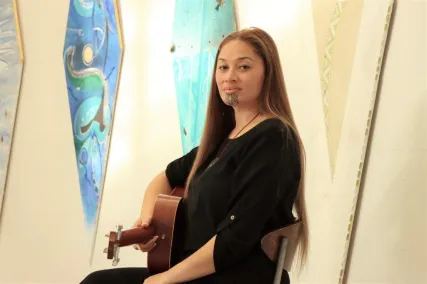 Two new exhibitions for Te Kōputu a te whanga a Toi - Ngā Mata o te Ariki Tāwhirimātea and Came From Te Kore - will bring Matariki alive with a very special event this Saturday evening.
Two new exhibitions for Te Kōputu a te whanga a Toi - Ngā Mata o te Ariki Tāwhirimātea and Came From Te Kore - will bring Matariki alive with a very special event this Saturday evening.
A fusion of passions through paint, earth and music, both shows have been specially chosen for the activity-packed season of Matariki celebrations at the Whakatāne Libraries and Galleries.
In the Sheaff Gallery, Erena Koopu visually captures the lyrical musings of Maisey Rika’s latest album, also named Ngā Mata o te Ariki Tāwhirimātea – or, The Eyes of the Chief Tāwhirimātea - which examines local tribal narratives of Matariki. Legend has it that Tāwhirimātea, the blind god of winds, flung his broken eyes into the heavens in a fit of grief, and they became the stars we know as Matariki, Tupuārangi, Waipuna-ā-Rangi, Waitī, Tupuānuku, Ururangi, Waitā, Pōhutukawa and Hiwa-i-te-Rangi.
Transferring musical movements to paint strokes, Erena attempts to convey the expressive sounds and the emotions they invoke to the eyes of the audience.
Erena’s artworks and Maisey’s music will be available to visitors to experience during the exhibition. The result is a combined narrative of iwi histories, emotion and whakapapa.
Erena and Maisey have taken the Matariki kaupapa a step further in this exhibition, creating new content around the star Rēhua, the ‘father’ of the cluster, who is not normally acknowledged.
Maisey will be launching her fresh single Rēhua with her band at the opening event, an exclusive opportunity for local fans of live music.
Writing the music for her album Ngā Mata o te Ariki Tāwhirimātea at home in Whakatāne in the midst of the 2020 rāhui, Maisey pondered the effects of this period of isolation on her friends and whānau. As a creative, Maisey felt the weight of responsibility to provide new inspiration and joy for a fearful world, and looking to the skies seemed the obvious choice of subject matter. Each song on the album celebrates the ancient kaupapa of a particular star of the Matariki cluster, inspired by Māori astronomer Dr Rangi Matamua. The music has been lovingly composed as a waiata and pūoro resource, intended as an addition to the Mātauranga Māori kete for future generations.
“If people are going to look to me for any type of uplift or guidance in these unknown times, I’m happy to help point them in the direction of the stars,” says Maisey. “Our tīpuna navigated here using astronomy, so the stars are a good place to restart. We need to go back to move forward into the future - nau mai e te tau hou, Matariki e ara e!”
An artist for the past 20 years, Erena has recently been inspired to paint the sounds of Māori composers who tell iwi, hapū and whānau narratives. Erena is a Kohanga Reo, Kura Kaupapa and Wharekura graduate who prides herself in all things Māori, and her current position as senior lecturer at EIT Tairāwhiti’s Toihoukura (School of Māori Visual Arts) allows her to share all aspects of Te Ao Māori with the next generation of art practitioners. For this exhibition, she has created a painting for each of the songs featured on Ngā Mata o te Ariki Tāwhirimātea.
The gallery opening event will also serve as the official welcome for a suite of new works by Pōneke artist, Tessa Williams. Came From Te Kore is a mixed media exhibition that explores mana tangata, an issue that has a contemporary and historical relevance for many iwi.
“My works depict the distance between myself, the place of my people and the place of my non-human ancestors,” describes Tessa.
Made with charcoal from Tessa’s father’s fireplace, the many facets of blackness and changeable textures reflect the light, and illuminate the diversity of Māori within the artist’s whakapapa. Tessa’s aim was to address the significance of collective mana, or mana tangata. She sees collective mana as the inherent mana from one’s ancestors, the mana of a community, and the often passed over mana of non-human ancestors, including the land we live on.
A category winner of the 2020 MMCA and a highly commended finalist in the recent Kīngi Tuheitia Portraiture awards, Tessa’s practice has concentrated on natural whenua – kōkōwai, charcoal and other earths - for the last few years.